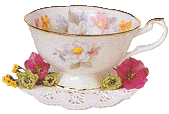Victorian Tea Time
The Victorian era was a kinder and gentler time. A
time when women were ladies and men were gentlemen.
An era when strict morals and etiquette ruled the
day. When afternoon teas were a social event. Calling
cards and flowers had a message of their own.
What is it about tea time that makes it so
appealing? Why are more and more tea rooms opening up
all over the country? It is because tea time brings
with it beauty, romance, elegance and friendship.
We will share with you many tips, quotes, recipes,
customs and the history of tea. We hope that you too
will partake in the centuries old custom of tea time.
Step back with us to this Victorian Era and share
a cup of tea.
The History and Customs of Tea

~The History of Tea~
Tea was discovered in China almost 5,000 years
ago! In the early 28th century B.C. lived the second
Chinese emperor, Shen-Nung.� He was a man obsessed
with the notion that he could, by taking certain
precautions with regard to his body,� prolong his
life.� For instance, Shen-Nung was convinced that
drinking only water that had first been boiled helped
preserve his health. (proving he was truly a man of
his time!)�It is a fortunate result of his
different way of thinking that we now have the brew
loved the world over, Tea.
One day while touring his provinces, the emperor
sat down to rest and refresh himself.� As his
servants drew up a fire, they unwittingly used the
branches of a camellia sinesis plant. As the
emperor's water boiled over the fire, bits of leaves
drifted up off the burning boughs and settled in the
water.� As the leaves steeped, the emperor became
intrigued by the aroma of the brew and tasted it,
seeming to forget�his own fear as to what
poison the strange drink may hold.� But Shen-Nung was
pleased by it's�taste and calming
effect. Thus, tea was born!
The famous Ch'a Ching (meaning "Tea Bible"), was
written by Lu Yu in 800 A.D. This book outlines all
the Chinese methods and traditions of planting,
harvesting, brewing and serving tea.
~Tea as Medicine~
For many centuries after its discovery by Emperor
Shen-Nung, tea was used only for medicinal and
spiritual purposes.� The Chinese believed that tea
had a way of assisiting the mind in becoming sedate
and meditative, which, according to the Chinese
philosophy, is important to maintaining a healthy
person.� Because it was so revered, only Chinese
Buddhist monks were allowed to cultivate the tea
plant.�
The Custom of Taking Tea
  
When tea finally came to Europe it was a luxury only
the wealthy could afford, costing more then $100 a
pound in the late 1600's. Slowly, the amount of tea
imported increased, the price fell, and the sales
expanded.
As a craze of anything Oriental swept through
Europe, tea became a way of life. Marie de
Rabutin-Chantal, the Marquis de Seven makes the first
mention of adding milk to tea in 1680. Tea remained
popular in France for only about fifty years, being
replaced by a preference to wine, chocolate and
coffee.
The "Tea Mania" swept through England, just as it
had through Holland and France. Tea imports rose from
40,000 pounds in 1699 to 240,000 pounds in 1708.
In 1840 Anna, 7th Duchess of Bedford,
had tea sent to her room one afternoon along
with a tray of bread, jam, butter, small tea cakes
and clotted cream.
She formed this habit and found she could not
break it.� Her friends picked up the custom and
as the century progressed, afternoon tea became
increasingly elaborate.
Queen Victoria , relished the new craze for
tea-parties. By 1855 the Queen and her ladies
were in formal dress for the afternoon teas.
By the 1880s ladies all over England were
changing into long tea gowns for the occasion,
appetites sharpened by the customary afternoon drive
in a carriage.� The tea gowns were soft, festooned with lace, and always long and
flowing. Ladies carried ornate fans to cool
themselves in the afternoon heat.
Ladies and Gentlemen began to take their tea
outside surrounded by entertainment such as an
orchestra. On the grounds were flowered walkways, bowling
greens, concerts and fireworks at night.
Women were permitted to enter a mixed public
gathering for the first time.( Now that's another whole chapter! )
Types of Teas
   
Afternoon Tea is served at approximately four o'clock
and can consist of whatever the hostess chooses
sandwiches, scones, cookies, a special dessert such
as a fruit tart or a rich cake. It can be formally
served in the dining room or at the living room tea
table. Informal teas can be enjoyed in the kitchen,
garden, as a picnic, or any location of choice.
Farmer's Tea is a combination of a Ploughman's
Lunch (heavy grained bread, sharp cheese, fruit, and
sausages or a meat pie), popular in British pubs,
served with a sweet.
Full Tea is a complete four-course Afternoon Tea
with sandwiches, scones, sweets, and a dessert
finale.
Royal Tea adds a glass of champagne or sherry to
the Full Tea.
Light Tea is a lighter version of Afternoon Tea
with a scone and a sweet.
Cream Tea is one where heavy whipped or clotted
cream is served to spread on the warm scones along
with strawberry jam. It doesn't refer to the milk you
put in your tea.
High Tea is most often served as a Full Tea, only
more of the same. It is enjoyed at approximately six
o'clock and is a light supper for the family or a
before-theater meal. An entree such as chicken a la
king or meat pie may be served with breads, biscuits,
salad, cheese, fruit, and sweets.
Recipes for Tea Time Sweet Delights
Back to Our Cookbook
Index

|